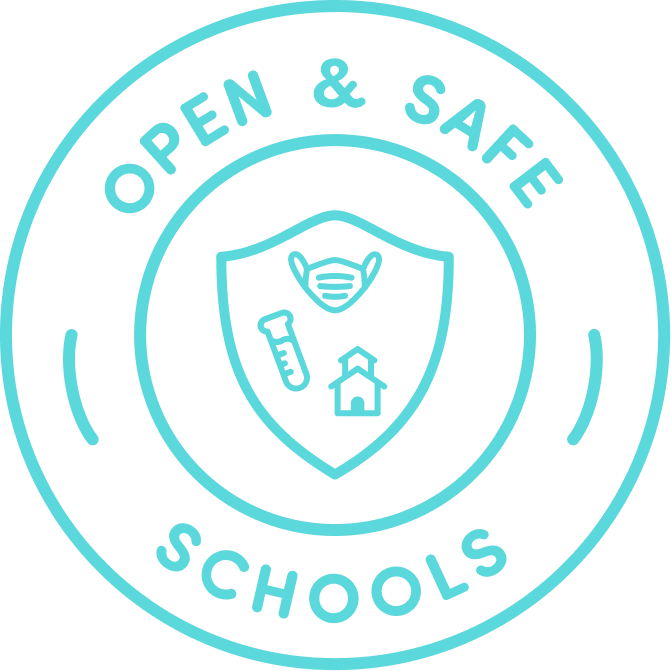Overview
+ Why do we need to test? ▿
See our section on Why to Test.
The goal of regular COVID-19 testing in schools is to quickly identify cases before they become outbreaks. When used alongside other prevention strategies, like distancing and face masks, testing creates an additional level of reassurance that it is safe to keep schools open with students and educators in the classroom in person.
+ Do we still need to wear masks and distance when we are testing? ▿
See our section on School COVID-19 Testing is Part of Broader Prevention Strategies .
Yes. Testing is just one layer of protection. Prevention measures like masks and distancing are also crucial.
+ If I'm vaccinated, should I still get tested regularly? ▿
According to CDC guidance for fully vaccinated people, updated on April 29, 2021, fully vaccinated asymptomatic people without an exposure may be exempted from routine screening testing, if feasible.
Federal Government Programs
+ How can I fund my testing program? ▿
See our section on Federal Support for School Testing.
Testing Operations
+ Does the vendor that does the swabbing or saliva sample collection for the younger kids have to be a healthcare professional (e.g. school nurse)? If not, how do we train this person? ▿
See our section on Identifying your Testing Team.
While school nurses tend to make great candidates, a nursing degree or specialized medical training is not necessary to fulfill any of these roles. Training materials are provided by your vendor.
+ Can kids younger than second grade self-collect? ▿
Some schools have had success with younger students self-swabbing.
+ What’s the best way to set up the testing station or system in school? ▿
See our section on Choosing Specimen Collection Methods.
There are more and more great examples emerging as well. Reach out to a school mentor via the Peer-to-Peer hub to talk through ideas.
+ What PPE is needed? ▿
Anterior nasal swabs and saliva tests are not considered to be aerosol generating procedures, but PPE is recommended for people administering or observing the tests simply because, at times, they need to be close to the individual being tested.
See our section on Choosing Specimen Collection Methods for details on keeping school personnel safe.
+ How do we protect the privacy of students and staff? ▿
The data systems vendors use to report results should all HIPAA-compliant - please check with your vendor. When a positive case is identified through an individual diagnostic test, that student or staff member should be immediately isolated. Doing so in a way that protects their privacy is important. We recommend talking to the person away from other students or staff. Remember that there are many reasons an individual might have to stay home from school and do not engage in speculation about why they are home.
+ Do individuals have to blow their nose before giving a nasal sample? ▿
This depends on the instructions from the lab. Ask your testing vendor if you’re not sure if this applies to you or not.
+ Do individuals have to abstain from eating and drinking before giving a saliva sample? ▿
In most cases, yes. Ask your testing vendor for specifics.
+ Is pooled testing a good option for our school? ▿
Some testing service providers or labs may offer pooled testing products, in which multiple specimens are put together in a pool and tested one time. If the pool is negative, then every indivdiual specimen is considered negative. If the pool is positive, than the individual specimens need to retested to identify the positive(s). This can be a great way to enhance testing capacity and decrease cost.
Ask your vendor if they can offer pooled testing. Pooling can be done by labs with individual tests authorized for pooling, under CLIA, with the capacity for reflex testing on positive pools to identify the individual positive specimens, utilizing tests in line with their EUA and under CLIA.
Consent and Communication
+ What rate of participation do I need to make my testing worth it? ▿
We don’t know exactly, but we do know that any testing is better than no testing. Every time you identify and isolate a positive, you have made your school community safer.
+ How do I collect consent? ▿
See our sections on Getting Consent and Increasing Participation for details.
+ How do I introduce my school community to the program and get them to sign up? ▿
See our communications toolkit which includes templates and messages for both families and for educators and other staff.
+ How do I increase participation? ▿
See our section on Increasing Participation.
We recommend regular and repeated communications about the program through various channels (email, paper, robo call, social media) to reach families. Some schools have also required testing for participation in sports or other after school activities. If you’d like to talk to a school that is working through the same challenges, we recommend searching the Peer-to-Peer hub to find a mentor school to discuss with.
+ What happens when we find the positive case? ▿
Please see our sections on Case Identification and Contact Tracing and Communicating about Positive Cases
When you find a positive case, the first thing to remember is that this is a good thing - you just made your school safer for everyone! Second, you should deploy your contact tracing protocol that you have developed in collaboration with your local Board of Health.
